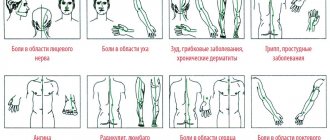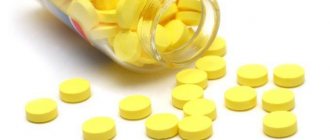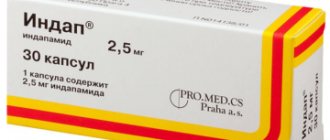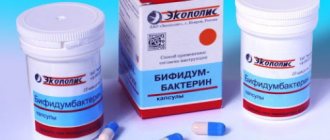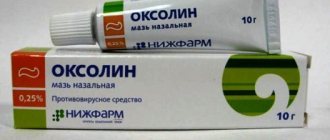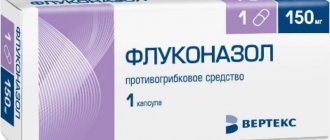Release forms, composition
The medicine against fever and pain is available in the form of round, white or slightly yellowish coated tablets, packaged in contour cells (10 pieces per blister). One cardboard box contains from one to five blisters and instructions for use.
The drug works due to the active component – ibuprofen. One tablet contains 200 or 400 mg of active ingredient. In addition to the compound that stops the inflammatory process, starch, dye, low molecular weight polymer, sorbate and stearic acid are added to the medicine.
Overdose symptoms and what to do
Overdose (accidental/intentional) is expressed in the following symptoms:
- a constant desire to sleep, accompanied by weakness, loss of stamina and physical strength;
- nausea accompanied by vomiting (frequent or profuse);
- pain and heaviness in the abdomen;
- noise (can occur with ringing or with increasing intensity) in the ears;
- headache;
- the pulse becomes rapid.
You need to do the following:
- washing the stomach with water (most effective in the first hour);
- taking activated carbon or any available intestinal sorbent.
There is no special drug - an antidote to relieve the consequences and manifestations of an overdose, so it is necessary to carry out therapeutic measures according to the condition. You need to act quickly, as in case of severe poisoning, coma or cardiac arrest is possible.
Pharmacological action and pharmacokinetics
In the presence of the main active component of the tablets, the enzyme cyclooxygenase 1 and 2 suspends its action, as a result of which the reaction of converting arachidonic acid into prostaglandins stops. Prostaglandins are lipid compounds that transmit impulses from one cell to another. They trigger the process of inflammation, which results in pain.
The action of the drug is aimed at relieving swelling around the diseased joint, reducing pain and lowering temperature. The pain becomes less pronounced both at rest and with movement. Under the influence of the drug, motility, constrained by joint inflammation, increases. Improved mobility is noted not only during the day, but also in the morning.
The medicine is best absorbed when taken separately from food. After consumption before meals, it is found in the blood in the highest concentrations after 45 minutes. If the tablet was taken after a meal, then the highest concentration can be detected no earlier than 1.5 hours later.
The chemical compound actively penetrates joint tissues and fluids. After 24 hours it is completely eliminated from the body. The anti-inflammatory effect develops cumulatively. To achieve tangible results, you need to take the tablets regularly for one or two weeks.
Inactivation of the active component occurs in the liver. Less than one percent of the chemical compound is utilized by the kidneys and bile. In elderly people, pharmacokinetics proceed at the same pace.
Indications for use
The drug can be used for diseases of the ENT organs and respiratory tract
For children, Ibuprofen is prescribed for feverish conditions against the background of acute respiratory viral infections, acute respiratory infections, and influenza. The drug can be used orally or rectally. After vaccination, many children develop a fever, so the use of the drug is also necessary for preventive purposes.
Ibuprofen can also be used to reduce pain from headaches, toothaches, migraines, earaches and sprains.
For adults, Ibuprofen is indicated for inflammatory diseases:
- Rheumatoid arthritis.
- Psoriatic arthritis.
- Spondylosis.
- Ankylosing spondylitis.
- Cervical migraine.
The drug is taken for any pain syndrome, including postoperative pain.
As an adjuvant, Ibuprofen is used in the treatment of infectious and inflammatory pathologies of the ENT organs, bronchitis, pneumonia, adnexitis, panniculitis, and inflammatory processes in the pelvis.
Dosage and rules of use
The dosage and course of treatment are prescribed by the doctor depending on the cause and age.
Adult Ibuprofen can be taken by children over 12 years of age. For children from 6 months of age, a children's drug is available with a dosage appropriate for this age.
It is important to strictly follow the prescribed dosage by your doctor to avoid the development of possible adverse reactions.
For adults, the daily dose is divided into several doses, and it does not exceed 1200 mg per day. You should drink no more than 6 tablets per day. The interval between taking the drug should be at least 4 hours. If the pain is too severe, you can take 2 tablets.
Ibuprofen tablets are taken 3-4 times a day, one tablet. It is recommended to take the first tablet on an empty stomach, and subsequent tablets after meals. This regimen increases the effectiveness of the drug and helps prevent unwanted side reactions. For children over 12 years of age, the dosage is calculated based on body weight: 20-40 mg per 1 kg per day.
Taking Ibuprofen for pain should not exceed 5 days, and for feverish conditions - 3 days. If symptoms do not go away, you should consult a doctor.
The dose of Ibuprofen as an antipyretic for children is calculated taking into account the degree of temperature increase:
- At a temperature of 38-39 degrees, the dose is 5 mg/kg.
- If the temperature is above 39 degrees, then the dosage is increased to 10 mg/kg per day.
The drug in the form of an ointment or gel is applied externally for 2-3 weeks. Rub the product into the affected area 3-4 times a day. It is worth noting that Ibuprofen is not compatible with certain medications, so it is best to use it only after prescription by a doctor.
Contraindications and side effects
Ibuprofen should not be taken together with other non-steroidal anti-inflammatory drugs
Ibuprofen should not be taken in the following cases:
- Hypersensitivity to individual components.
- Blood clotting disorder.
- Diseases of the gastrointestinal tract of an erosive and ulcerative nature.
- Gastrointestinal bleeding.
- Hemorrhages inside the skull.
- Liver and kidney failure.
- Liver pathology in the acute phase.
- Hyperkalemia.
The drug should not be used by children under 6 years of age.
For this age, the use of children's Ibuprofen is recommended. The drug should be taken with caution by people suffering from hypertension, ischemia, peptic ulcers, gastritis, colitis, as well as heart failure, nephrotic syndrome
If you take Ibuprofen correctly, without exceeding the dosage, then no adverse reactions are observed. If the drug is taken incorrectly, side effects from the gastrointestinal tract are possible in the form of decreased appetite, diarrhea, heartburn, nausea, etc. Shortness of breath, bronchospasm, increased blood pressure, dizziness, and headache may occur.
You can learn more about what non-steroidal anti-inflammatory drugs are from the video:
Children may experience allergic reactions in the form of skin rash, itching, and allergic rhinitis. In rare cases, anaphylactic shock develops.
In case of an overdose, the following symptoms appear. such as: nausea, vomiting, abdominal pain, headache, decreased blood pressure, tachycardia, bradycardia, etc. In this case, it is necessary to rinse the stomach, drink activated charcoal and drink plenty of alkaline drinks. If necessary, symptomatic therapy is carried out.
What does Ibuprofen help with?
This drug is intended to relieve pain caused by inflammation. The drug can also temporarily lower body temperature.
Among the indications:
- Swelling and decreased mobility of the limbs against the background of inflammation and destruction of joints as a result of the development of psoriasis, gout, rheumatism, spinal diseases, and autoimmune diseases.
- Pain of various nature: muscle, dental, headache, menstrual, post-traumatic, postoperative, associated with inflammation of the pelvic organs, with the development of cancerous tumors.
- Fever and fever associated with colds and flu.
The medicine has no therapeutic effect. It does not affect the course of the disease. Used only to relieve symptoms.
Ibuprofen during breastfeeding instructions
Ibuprofen during breastfeeding, the instructions for which are quite simple, can be used without risk to the fetus. Therefore, the answer to the question whether a nursing mother can drink this product is strictly positive. However, it is worth taking into account individual organismal characteristics and taking into account that the dosage in this state may differ from the amount of the drug used in the normal state. Here are a few situations in which this medicine will become a real lifesaver without any risk or threat to the baby.
- during fever and fever (from temperature);
- in case of inflammation of the musculoskeletal system;
- with painful menstruation;
- helps relieve headaches and migraines;
- from pain syndrome of different localization (from toothache, joint sensation).
Before using the drug, you must consult with your doctor.
Instructions for use and dosage of Ibuprofen
To reduce the effect on the gastrointestinal tract, tablets are taken after meals. The recommended interval between doses is 6 hours. You can take the medicine again no earlier than four hours later.
For children
The dosage form of the tablet can be taken by children over six years of age. The child's weight must be at least 20 kg. A single dose for a representative of the younger group of patients is 200 mg. The maximum number of Ibuprofen doses per day for children is four.
For adults
Adults and children over 12 years of age are prescribed the same single dose – 400 mg. It is acceptable to take tablets (400 mg) up to three times a day. After 18 years of age, no more than 1200 mg of the active substance is allowed per day. Patients under the age of majority can drink no more than 1000 mg of Ibuprofen per day.
Without examination by a specialist, the drug can be taken as an antipyretic or pain reliever for no longer than three days in a row.
Contraindications
- erosive and ulcerative changes in the mucous membrane of the stomach or duodenum, active gastrointestinal bleeding;
- renal failure (creatinine clearance less than 30 ml/min), progressive kidney disease;
- confirmed hyperkalemia;
- hemophilia and other bleeding disorders (including hypocoagulation), hemorrhagic diathesis;
- in the period after coronary artery bypass surgery;
- pregnancy (III trimester);
- inflammatory bowel diseases in the acute phase, incl. ulcerative colitis;
- anamnestic data on an attack of bronchial obstruction, rhinitis, urticaria after taking acetylsalicylic acid or another non-steroidal anti-inflammatory drug (complete or incomplete acetylsalicylic acid intolerance syndrome - rhinosinusitis, urticaria, polyps of the nasal mucosa, bronchial asthma);
- liver failure or active liver disease;
- children's age: up to 6 years and from 6 to 12 years (with body weight less than 20 kg) - for tablets 200 mg; up to 12 years – for tablets 400 mg;
- hypersensitivity to any of the ingredients included in the drug.
With caution: elderly age, congestive heart failure, cerebrovascular disease, arterial hypertension, coronary heart disease, dyslipidemia/hyperlipidemia, diabetes mellitus, peripheral arterial disease, nephrotic syndrome, CC less than 30-60 ml/min, hyperbilirubinemia, gastric and duodenal ulcers intestines (history), presence of Helicobacter pylori infections, gastritis, enteritis, colitis, long-term use of NSAIDs, blood diseases of unknown etiology (leukopenia and anemia), pregnancy (I-II) trimester, lactation period, smoking, frequent alcohol consumption (alcoholism) , severe somatic diseases, concomitant therapy with the following drugs: anticoagulants (for example, warfarin), antiplatelet agents (for example, acetylsalicylic acid; clopidogrel), oral glucocorticosteroids (for example, prednisolone), selective serotonin reuptake inhibitors (for example, citalopram, fluoxetine, paroxetine, sertraline ).
Use during pregnancy and lactation
During pregnancy and lactation, the product can only be used as prescribed by a doctor. For pregnant women, Ibuprofen is considered less dangerous than other analgesics and acetylsalicylic acid. The likelihood of uterine bleeding while taking it is negligible.
It is worth mentioning that the drug is allowed to be used only in the first and second trimester of pregnancy. At later stages, it is strictly prohibited, since it reduces the synthesis of hormones responsible for labor, and can also provoke the intrauterine development of pulmonary failure in the fetus and baby.
During the period of breastfeeding, the drug is not discontinued.
What is Ibuprofen prescribed for?
The drug is used both as an independent remedy and as part of complex treatment, as an adjuvant for various pathologies.
Ibuprofen can have a therapeutic effect when:
- rheumatoid arthritis, including Still's disease;
- pain due to sprain;
- osteoarthritis;
- inflammation of the membranes of the joints;
- ankylosing spondylitis;
- bursitis;
- tendinitis;
- tendovaginitis;
- pain in the lower back;
- painful menstruation;
- recurrent or regular headaches, as well as migraines;
- neuralgia;
- dysmenorrhea;
- postoperative and dental pain.
As part of complex treatment, Ibuprofen is prescribed for adnexitis and proctitis. This medicine is also used to eliminate signs of fever during influenza and ARVI.
Drug interactions with other drugs
- The combined use of the drug in question and other non-steroidal anti-inflammatory drugs increases the risk of bleeding. The same effect is observed with the simultaneous administration of tablets and drugs that reduce the rate of blood clotting.
- Co-administration with drugs for the treatment of depression is not recommended. Due to combination therapy, there is a risk of gastric bleeding.
- These tablets increase the concentration of drugs that artificially suppress the effect of immunity (cyclosporine and drugs containing gold). As a result, the load on the kidneys increases and the threat of developing a nephrotoxic effect increases.
- Drugs that block calcium and increase heart rate increase the amount of drug in the blood.
- Substances that accelerate microsomal oxidation, such as ethyl alcohol, tricyclic antidepressants and barbiturates, increase the danger of the drug in question for the liver. Their combined use is fraught with the development of toxic shock. Substances, on the contrary, suppress microsomal oxidation neutralize the hepatotoxic effect.
- The medicine is incompatible with vasodilators. It reduces their overall calming effect on the central nervous system.
- Simultaneous use with estrogens and corticosteroids provokes the appearance of hematomas and bleeding.
- To avoid increasing the load on the liver, it is not recommended to take tablets with medications that primarily decompose in the hematopoietic organ.
- The drug enhances the effect of insulin and increases the toxicity of antitumor drugs.
Interaction of Ibuprofen with other drugs
Concomitant use of other NSAIDs (including acetylsalicylic acid) should be avoided.
Ibuprofen potentiates the effect of thrombolytics and anticoagulants, as well as insulin and oral agents to lower blood glucose levels.
Sertraline, Citaprolam, and Fluoxetine increase the likelihood of bleeding in the digestive tract.
The likelihood of hepatotoxicity of Cyclosporine increases. The effectiveness of vasodilators decreases, as does the activity of diuretics (Hydrochlorothiazide, Furosemide, Lasix).
Steroid hormones, estrogens and colchicine increase the likelihood of gastrointestinal ulcers.
Caffeine can enhance the analgesic effect of Ibuprofen.
Ibuprofen: contraindications, side effects and overdose
Cases in which the use of the drug is contraindicated:
- tendency to be allergic to any of the constituent components;
- intolerance to acetylsalicylic acid and other non-steroidal analgesics;
- combination in any combination of aspirin intolerance with bronchial asthma, polyposis of the nasal and sinus mucosa.
The drug is not prescribed:
- patients suffering from inflammatory and ulcerative diseases of the stomach and intestines that are in an acute or active stage;
- people with bleeding disorders, a tendency to hemorrhage, internal bleeding, including intracranial;
- patients with obvious insufficiency of liver function and renal pathologies in the active phase;
- pregnant women over 30 weeks and children under six years of age.
For elderly patients and patients with heart pathologies, this drug is prescribed only after a comprehensive examination. It should not be taken without a doctor's recommendation.
The drug tends to affect the gastrointestinal tract. As a result of its use, in some cases, diffuse abdominal pain and disruption of digestive processes are observed.
In addition, other negative reactions from various organs and systems are possible:
- The active substance increases the risk of internal bleeding. In most cases, this symptom occurs suddenly. Among people with spontaneously opened hemorrhages, 60% are those who have recently taken non-steroidal anti-inflammatory drugs.
- When taking the drug, the moisture content of the oral mucosa deteriorates, and ulcerative lesions of the gums occur. In some cases, erosive stomatitis is observed.
- Non-CNS effects have been reported: headaches, nervousness, insomnia, and, in rare cases, loss of consciousness and hallucinations. People prone to autoimmune diseases have a small risk of developing meningitis.
- From the sensory organs, dry eye membranes, blurred vision, and inflammation of the optic nerve are observed.
- Sometimes the pills cause shortness of breath and bronchospasm.
- This drug can cause swelling, various rhinitis and dermatitis, rejection of skin membranes and all kinds of allergic reactions.
- According to blood tests, anemia may be observed as a side effect when using the drug. Other effects include increased sweating.
In case of an overdose of the drug, blood pressure readings drop sharply. There is darkening of the eyes and noise in the ears. The patient may vomit. He loses consciousness and orientation in space.
The victim requires gastric lavage, activated carbon, alkaline drinks and symptomatic treatment medications.
Substance-powder Ibuprofen (Ibuprofen)
Instructions for medical use of the drug
Description of pharmacological action
Non-selectively inhibits COX-1 and COX-2, reduces PG synthesis. The anti-inflammatory effect is associated with a decrease in vascular permeability, improved microcirculation, a decrease in the release of inflammatory mediators (PG, kinins, LT) from cells and suppression of energy supply to the inflammatory process. The analgesic effect is due to a decrease in the intensity of inflammation, a decrease in the production of bradykinin and its algogenicity. In rheumatoid arthritis, it affects predominantly the exudative and partly the proliferative components of the inflammatory response, has a rapid and pronounced analgesic effect, reduces swelling, morning stiffness and limited mobility in the joints. A decrease in the excitability of the heat-regulating centers of the diencephalon results in an antipyretic effect. The severity of the antipyretic effect depends on the initial body temperature and dose. With a single dose, the effect lasts up to 8 hours. With primary dysmenorrhea, it reduces intrauterine pressure and the frequency of uterine contractions. Reversibly inhibits platelet aggregation. Because PGs delay closure of the ductus arteriosus after birth, COX inhibition is believed to be the primary mechanism of action of ibuprofen when administered IV to neonates with a patent ductus arteriosus.
Indications for use
Rheumatoid arthritis, osteoarthritis deformans, ankylosing spondylitis, gout, pain in the spine, neuralgia, myalgia, bursitis, radiculitis, traumatic inflammation of soft tissues and the musculoskeletal system, adnexitis, proctitis; infectious and inflammatory diseases (adjuvant).
Release form
Powder substance; plastic bag (pouch) 25 kg cardboard drum 1; Powder substance; plastic bag (bag) 40 kg cardboard drum 1; Powder substance; polyethylene bag (bag) 15 kg fiber drum 1; Powder substance; polyethylene bag (bag) 20 kg fiber drum 1; Powder substance; polyethylene bag (bag) 25 kg fiber drum 1; Powder substance; bag (bag) double-layer polyethylene 5 kg drum 1; Powder substance; bag (bag) double-layer polyethylene 10 kg drum 1; Powder substance; bag (bag) double-layer polyethylene 20 kg drum 1; Powder substance; bag (bag) double-layer polyethylene 25 kg drum 1;
Pharmacodynamics
Non-selectively inhibits COX-1 and COX-2, reduces PG synthesis. The anti-inflammatory effect is associated with a decrease in vascular permeability, improved microcirculation, a decrease in the release of inflammatory mediators (PG, kinins, LT) from cells and suppression of energy supply to the inflammatory process. The analgesic effect is due to a decrease in the intensity of inflammation, a decrease in the production of bradykinin and its algogenicity. In rheumatoid arthritis, it affects predominantly the exudative and partly the proliferative components of the inflammatory response, has a rapid and pronounced analgesic effect, reduces swelling, morning stiffness and limited mobility in the joints. A decrease in the excitability of the heat-regulating centers of the diencephalon results in an antipyretic effect. The severity of the antipyretic effect depends on the initial body temperature and dose. With a single dose, the effect lasts up to 8 hours. With primary dysmenorrhea, it reduces intrauterine pressure and the frequency of uterine contractions. Reversibly inhibits platelet aggregation.
Pharmacokinetics
When taken orally, it is well absorbed from the gastrointestinal tract. Cmax is created within 1 hour, when taken after meals - within 1.5–2.5 hours. Plasma protein binding - 90%. Slowly penetrates into the joint cavity, but lingers in the synovial tissue, creating higher concentrations in it than in plasma. Biological activity is associated with the S-enantiomer. After absorption, about 60% of the pharmacologically inactive R-form is slowly transformed into the active S-form. Subject to biotransformation. There are 3 known main metabolites excreted by the kidneys. No more than 1% is excreted unchanged in the urine. It has a two-phase elimination kinetics with T1/2 from plasma of 2–2.5 hours (for retard forms - up to 12 hours).
Use during pregnancy
Contraindicated in the third trimester of pregnancy, in the first and second trimesters - with caution. Breastfeeding should be stopped during treatment.
Contraindications for use
Hypersensitivity, gastric and duodenal ulcers, ulcerative colitis, aspirin-induced asthma, hematopoietic disorders, amblyopia, impaired color vision, severe renal and liver dysfunction, children under 6 years of age.
Side effects
Nausea, anorexia, flatulence, constipation, heartburn, diarrhea, dizziness, headache, agitation, insomnia, allergic skin reactions, visual impairment. Rarely - erosive and ulcerative lesions of the gastrointestinal tract.
Directions for use and doses
Inside, after eating. For rheumatoid arthritis - 0.8 g 3 times a day; for osteoarthritis and ankylosing spondylitis - 0.4-0.6 g 3-4 times a day, for juvenile rheumatoid arthritis - 30-40 mg/kg per day in several doses. For soft tissue injuries, sprains - 1.6–2.4 g per day in several doses. For moderate pain syndrome - 1.2 g per day.
Overdose
Symptoms: abdominal pain, nausea, vomiting, lethargy, drowsiness, depression, headache, tinnitus, metabolic acidosis, coma, acute renal failure, hypotension, bradycardia, tachycardia, atrial fibrillation and respiratory arrest. Treatment: gastric lavage (only during the first hour after ingestion), activated charcoal (to reduce absorption), alkaline drinking, forced diuresis and symptomatic therapy (correction of acid-base balance, blood pressure, gastrointestinal bleeding).
Interactions with other drugs
The simultaneous use of two or more NSAIDs should be avoided due to the increased risk of side effects. With simultaneous use, ibuprofen reduces the anti-inflammatory and antiplatelet effect of acetylsalicylic acid (an increase in the incidence of acute coronary insufficiency in patients receiving small doses of acetylsalicylic acid as an antiplatelet agent is possible after starting ibuprofen). When used with thrombolytic drugs (alteplase, streptokinase, urokinase), the risk of bleeding simultaneously increases. Ibuprofen enhances the effect of indirect anticoagulants, antiplatelet agents, and fibrinolytics. Inducers of microsomal oxidation (phenytoin, ethanol, barbiturates, rifampicin, phenylbutazone, tricyclic antidepressants) increase the production of hydroxylated active metabolites, increasing the risk of severe hepatotoxic reactions. Microsomal oxidation inhibitors reduce the risk of hepatotoxicity. Antacids and cholestyramine reduce the absorption of ibuprofen. Caffeine enhances the analgesic effect of ibuprofen. Cefamandole, cefoperazone, cefotetan, valproic acid increase the incidence of hypoprothrombinemia. Myelotoxic drugs enhance the manifestations of hematotoxicity of ibuprofen. Cyclosporine and gold preparations enhance the effect of ibuprofen on the synthesis of PG in the kidneys, which is manifested by increased nephrotoxicity. Ibuprofen increases the plasma concentration of cyclosporine and the likelihood of developing its hepatotoxic effects. Drugs that block tubular secretion reduce excretion and increase plasma concentrations of ibuprofen. Ibuprofen reduces the effect of antihypertensive drugs (including CCBs and ACE inhibitors), the natriuretic and diuretic activity of furosemide and hydrochlorothiazide, and the effectiveness of uricosuric drugs. Increases the side effects of mineralocorticoids, glucocorticoids, estrogens, ethanol. Enhances the effect of oral hypoglycemic drugs and insulin. Increases the blood concentration of digoxin, lithium and methotrexate. Ibuprofen may reduce the clearance of aminoglycosides (coadministration may increase the risk of nephrotoxicity and ototoxicity). Ibuprofen for intravenous administration should not be mixed with other drugs.
Precautions for use
Treatment with ibuprofen should be carried out in the minimum effective dose, in the shortest possible short course. During long-term treatment, monitoring of the peripheral blood picture and the functional state of the liver and kidneys is necessary. Considering the possibility of developing NSAID gastropathy, it is prescribed with caution to elderly people, with a history of stomach ulcers and other gastrointestinal diseases, gastrointestinal bleeding, with simultaneous therapy with glucocorticoids, other NSAIDs and for long-term therapy. When symptoms of gastropathy appear, careful monitoring is indicated (including esophagogastroduodenoscopy, blood test to determine hemoglobin, hematocrit, stool test for occult blood). To prevent the development of NSAID gastropathy, it is recommended to combine it with PGE drugs (misoprostol). Prescribe with caution to patients with impaired liver and kidney function (regular monitoring of bilirubin levels, transaminases, creatinine, and renal concentrating ability is required), arterial hypertension and chronic heart failure (daily monitoring of diuresis, body weight, blood pressure). If visual impairment occurs, the dose should be reduced or the drug discontinued. It is not recommended to consume alcoholic beverages during treatment. Do not apply to open wound surfaces or damaged skin; Avoid contact of cream, gel or ointment with eyes and mucous membranes.
Storage conditions
List B.: In a dry place, protected from light, at a temperature below 25 °C.
Best before date
36 months
ATX classification:
M Musculoskeletal system
M01 Anti-inflammatory and antirheumatic drugs
M01A Non-steroidal anti-inflammatory drugs
M01AE Propionic acid derivatives
M01AE01 Ibuprofen
Antipyretic analogues
The pharmaceutical drug is produced both under the original name and in the form of numerous analogues, among which there are such products as:
- Advil, tablets (ibuprofen 400 mg for adults and children over 12 years of age);
- "Ibufen", suspension ("Nurofen" for children) with 100 mg of active ingredient in every 5 ml of the drug;
- "MIG-400", film-coated tablets with a dosage of 400 mg;
- "Nurofen" in tablet form (200 mg);
- “Nurofen for children” (suspension 100 mg/5 ml);
- "Pedea", ampoules with solution for intravenous injections (10 mg/2 ml);
- "Solpaflex" tablets and capsules 200 mg;
- "Faspik", dosage form - tablets, dosage - 400 mg.
All of the listed drugs are taken according to regimens similar to the original drug.
Since 2000, several mass observations have been carried out, as a result of which a number of negative effects from non-steroidal painkillers have been identified. Among the risks provoked by them, there is a tendency to sudden gastric bleeding and the development of a heart attack. From which it follows that this category of drugs cannot be unreasonably prescribed to oneself, bypassing the doctor’s recommendations.
Ibuprofen analogues are cheaper in price
When considering the drug Ibuprofen, analogues are cheaper, you need to know them first. After all, this will allow you to save money without losing the effect and without compromising the final therapeutic result.
- Advil . This is a drug related to the NSAID group. It has powerful and pronounced anti-inflammatory, analgesic, and antipyretic properties. The price is about 50 rubles per package.
- Burana . Another effective substance in the fight against pain syndromes and sensations. It has many advantages. The tablets are cheap and cost from 77 rubles per pack.
- Nurofen . An effective medicine for pain and colds, taken by children and adults. It is available in many forms, tablets cost from 180 rubles per pack.
special instructions
Before you start taking Ibuprofen tablets, you must carefully read the instructions for the drug. There are a few special instructions that you should pay attention to before using it, these include:
- Treatment must be carried out in the minimum effective dose and in a short course, which should not exceed 5 days.
- In case of long-term use of Ibuprofen tablets, periodic laboratory monitoring of the functional activity of the liver, kidneys, and blood clotting is necessary.
- Concomitant use with other drugs from the pharmacological group of non-steroidal anti-inflammatory drugs is not recommended.
- If laboratory determination of the level of ketosteroids in the blood is necessary, 48 hours before the test, the drug is discontinued, since its use may affect the reliability of the results.
- For children aged 6 to 12 years, the drug can only be used under the supervision of a doctor.
- While taking the drug, it is recommended to refrain from activities that require increased concentration and speed of psychomotor reactions.
Analogs
Analogues of the drug Ibuprofen
- Advil.
- ArthroCam.
- Bonifen.
- Brufen.
- Brufen retard.
- Burana.
- Deblock.
- Children's Motrin.
- Dolgit.
- Ibuprom.
- Ibuprom Max.
- Ibuprom Sprint Caps.
- Ibuprofen Lannacher.
- Ibuprofen Nycomed.
- Ibuprofen-Verte.
- Ibuprofen-Hemofarm.
- Ibusan.
- Ibutop gel.
- Ibufen.
- Yprene.
- MIG 200.
- MIG 400.
- Nurofen.
- Nurofen for children.
- Nurofen Period.
- Nurofen UltraCap.
- Nurofen forte.
- Nurofen Express.
- Pedea.
- Solpaflex.
- Faspik.
When choosing analogues, it is important to understand that the instructions for use of Ibuprofen, the price and reviews of drugs with similar effects do not apply. It is important to consult a doctor and not change the drug yourself.
Ibuprofen or Nurofen - which is better?
Nurofen is a medicine based on ibuprofen. That is, the drugs are generics. They are distinguished from each other by manufacturer, price and composition of auxiliary components.


